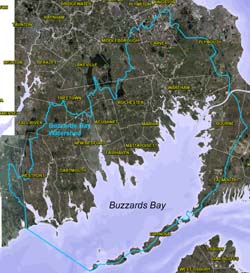
The Buzzards Bay National Estuary Program (NEP) will update its Comprehensive Conservation and Management Plan (CCMP) in 2024. The purpose of the CCMP is to define goals and approaches to protect and restore water quality and living resources in Buzzards Bay and its surrounding watershed. Approaches and recommendations contained in the CCMP not only define the work of the NEP and establish eligibility for our grant and technical assistance programs, but priorities in the CCMP are considered by several other state and federal grant programs as well.
As part of the CCMP update, the NEP must undertake a climate change vulnerability assessment to determine how climate stressors might affect our collective ability to meet the goals and objectives in the CCMP. The results of the climate change vulnerability assessment will be reflected in the 2024 CCMP update. The NEP completed its Climate Change Vulnerability Assessment for the Buzzards Bay CCMP (CCVA) in 2022 and finalized it in 2023. The effort was supported by the Buzzards Bay Coalition which hosted three workshops targeting the following interest groups: state/federal personnel and scientists, regional/municipal personnel, and non-profits/the public. These workshops were used to solicit comments and suggested approaches, exchange ideas, and help us improve upon a 2022 draft Climate Vulnerability Assessment. The workshops held were as follows:
- State and Federal Managers and Scientists Workshop: February 2022
- Regional and Municipal Government Workshop: March 2022
- Non-Profits and the Public Workshop: March 2022
These workshops were gauged to identify which climate stressors and climate impacts were of the highest priority and of greatest concern to the workshop participants using. Vulnerabilities in the following CCMP Action Plans were ranked based on participant interests or concerns.
Participants ranked the climate vulnerabilities of these Action Plans
Action Plan 1. Managing Nitrogen Sensitive Embayments
Action Plan 2. Protecting and Enhancing Shellfish Resources
Action Plan 3. Managing Stormwater Runoff and Promoting LID
Action Plan 4. Improving Land Use Management and Promoting Smart Growth
Action Plan 5. Managing Onsite Wastewater Disposal Systems
Action Plan 6. Managing Impacts from Boating, Marinas, and Moorings
Action Plan 7. Protecting and Restoring Wetlands
Action Plan 8. Restoring Migratory Fish Passage and Populations
Action Plan 9. Protecting Bio-Diversity and Rare and Endangered Species Habitat
Action Plan 10. Managing Water Withdrawals to Protect Wetlands, Habitat, and Water Supplies
Action Plan 11. Managing Invasive and Nuisance Species
Action Plan 12. Protecting Open Space
Action Plan 13. Protecting and Restoring Ponds and Streams
Action Plan 14. Reducing Beach Debris, Marine Floatables, and Litter in Wetlands
Action Plan 15. Managing Coastal Watersheets, Tidelands, and the Waterfront
Action Plan 16. Reducing Toxic Pollution
Action Plan 17. Preventing Oil Pollution
Action Plan 18. Planning for a Shifting Shoreline and Coastal Storms
Action Plan 19. Protecting Public Health at Swimming Beaches
Action Plan 20. Monitoring Management Action, Status, and Trends
Action Plan 21. Enhancing Public Education and Participation